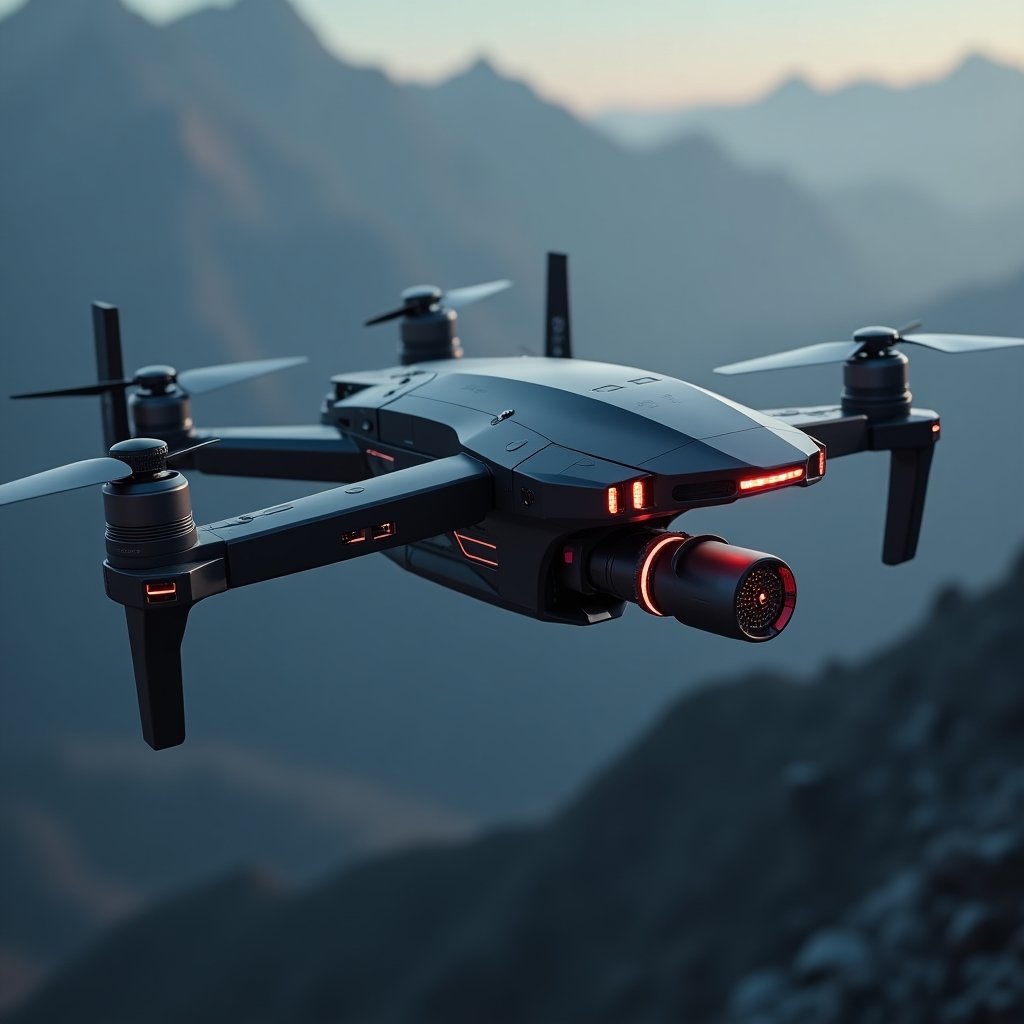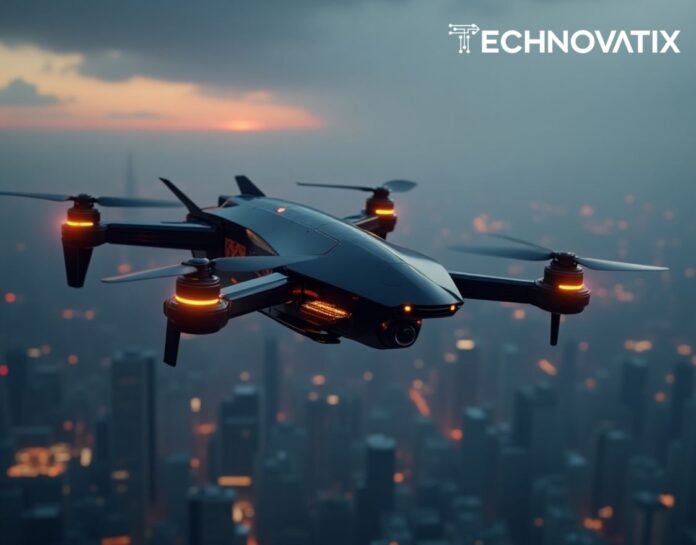The Black Falcon Drone has gained attention in the USA for its advanced design, strong performance, and wide use in defense, delivery, and research. Yet, its true potential is still limited by traditional batteries that restrict flight range, charging speed, and safety. This is where solid-state batteries in drones come into focus.
Unlike older power sources, they bring higher efficiency, better safety, and longer endurance. For a model like the Black Falcon, this shift means real progress in drone flight time improvement, battery safety for drones, and even payload capacity in drones. The future of this aircraft depends heavily on drone battery technology moving to the next stage
Introduction to the Black Falcon Drone
The Black Falcon Drone is not just another flying machine. It’s fast, reliable, and built for serious work like defense, farming, and inspection. People in the U.S. use it for tough jobs where normal drones don’t last long. It comes with strong sensors, a smart navigation system, and can carry heavy equipment.
But here’s the problem. Its power source is old. Right now, it uses lithium-ion or LiPo batteries. These packs don’t give enough drone flight time improvement. They also heat up, swell, and sometimes fail during missions. For a drone this advanced, that’s a big weakness.
1. Key features and specs of the Black Falcon Drone
The drone can carry cameras, sensors, and mapping tools. It’s designed for environmental monitoring drones, farming surveys, and even defense work. Strong hardware is there, but the battery holds it back.
2. Current battery limitations and user concerns
Most complaints are about the power. Flights are short. Charging takes time. Overheating is common. Some even face lithium dendrite formation issues that damage the pack. In short, the battery is the weak link.
Understanding Solid-State Batteries

Solid-state batteries in drones are different from what we use today. Instead of liquid inside, they use solid materials like ceramic electrolytes for drones or polymer electrolytes in solid-state batteries. This makes them safer and stronger.
When you compare lithium-ion vs solid-state batteries, the gap is clear. Solid-state gives more energy, lasts longer, and is less risky. It also reduces drone battery supply chain risks, which is good for industries in the U.S.
1. What makes them different from Li-ion/LiPo batteries
Liquid cells can leak or catch fire. Solid cells don’t. That’s the main difference. They’re stable, reliable, and ready for heavy use.
2. Advantages in energy density and safety
The biggest plus is high energy density batteries. You get more power in a smaller space. That means drone flight time improvement without extra weight. Plus, they handle heat better, fixing thermal management in drone batteries problems.
| Battery Type | Energy Density (Wh/kg) | Safety | Lifespan (cycles) |
|---|---|---|---|
| Li-ion / LiPo | 150–250 | Medium | 500–1,000 |
| Solid-State | 300–500 | High | 2,000+ |
Why Solid-State Batteries Matter for Drones
Switching to solid-state could change drones forever. Longer flights, safer packs, and more endurance make them perfect for jobs like drone delivery battery solutions. For defense and surveillance drones power, these batteries are a dream—strong, safe, and reliable.
They also perform well in tough climates. Cold mountains, hot deserts, or rainy cities don’t affect them as much. That’s why they’re better for drone performance in extreme temperatures.
1. Extended flight time and range
A drone with solid-state power can fly almost twice as long as one with Li-ion. That’s a huge drone flight time improvement for inspection, mapping, or defense.
2. Improved reliability in harsh conditions
Extreme weather is no longer a big problem. For environmental monitoring drones or defense patrols, these batteries keep performance steady.
3. Faster charging and longer cycle life
Fast charging solid-state batteries recharge quicker. They also last thousands of cycles, making them true long lifespan drone batteries. Less charging, more flying.
Potential Benefits for the Black Falcon Drone
For the Black Falcon Drone, solid-state power is a game-changer. More endurance, more payload, and safer flights. That’s what it means.
Think about payload capacity in drones. With better batteries, the Black Falcon can carry larger cameras, LiDAR, or even medical kits. It becomes useful for more missions.
1. Longer surveillance and mission endurance
With new batteries, the drone can stay in the air for hours. That means longer border patrols, farm checks, and big construction surveys.
2. Ability to carry heavier payloads
Payload capacity in drones improves. More tools, better sensors, and even delivery kits can be attached.
3. Safer operations with reduced overheating risks
Safer flights come from less heat and no swelling. No more sudden failures. Battery safety for drones finally improves.
Challenges of Integrating Solid-State Batteries
It’s not all smooth. Costs are high. A Panasonic solid-state drone battery or BEI lithium metal drone battery is far more expensive than a normal pack. Right now, only defense projects and big labs can afford them.
The scalability of solid-state batteries is another issue. Making them in bulk is hard. And older drones might not fit these packs without new customized drone battery packs.
1. Current cost barriers and limited availability
For regular users, the price is too high. Until it drops, drone delivery battery solutions won’t see wide adoption.
2. Manufacturing and scalability issues
Factories need new tech to build solid-state cells in bulk. That’s slowing things down.
3. Compatibility with existing drone systems
Not all UAVs can use these batteries yet. The Black Falcon may need design changes for charging and pack fitting.
Industry Trends and Future Outlook

The future of drone battery technology looks bright. The U.S. military is already testing UAVs with solid-state packs. Big names like DJI drone battery innovation and Panasonic solid-state drone battery are racing ahead.
The same tech is also being explored for eVTOL aircraft solid-state battery and Urban Air Mobility (UAM) batteries. Those breakthroughs will help drones too.
1. Timeline for commercial adoption in drones
Within 5–10 years, these batteries will move from labs to the market. Defense and industry first, consumer drones later.
2. Predictions for Black Falcon Drone upgrades
In the near future, the Black Falcon might run hybrid packs with polymer electrolytes in solid-state batteries. That means longer missions and more advanced AI-based flight systems.
Use Cases Enhanced by Solid-State Batteries
Solid-state makes drones more useful across the board. For defense and surveillance drones power, it means longer patrols. In case of farming, precision agriculture drone batteries help survey bigger lands. For deliveries, drone delivery battery solutions make last-mile drops more practical.
1. Military and defense applications
Defense drones gain endurance, safety, and reliability. This is vital for border patrols and battlefield intelligence.
2. Industrial inspection and mapping
From pipelines to farms, environmental monitoring drones and mapping drones can cover larger areas without breaks.
3. Delivery and logistics missions
Deliveries get faster and safer. Packages, medical supplies, and urgent goods can reach destinations without delay.
For readers who want to explore the latest innovations beyond drones, we recently covered some exciting updates in our Tech News August 2025 roundup. That article dives into new gadget news, breakthroughs in Blue AI, and other trends shaping the digital future. It’s a great companion piece if you’re curious about how broader technology shifts connect with the rise of solid-state batteries in drones.
FAQs About Solid-State Batteries and the Black Falcon Drone
What does Elon Musk say about solid-state batteries?
Elon Musk has said that solid-state batteries in drones and EVs are interesting but still face scalability and cost problems before mass adoption.
How do you change the battery in a drone?
Most drones, including customized drone battery packs, use a slide-and-lock mechanism where you remove the old pack and insert the new one easily.
Are solid-state batteries really coming?
Yes, companies like Panasonic solid-state drone battery and BEI lithium metal drone battery are pushing development, and first uses are expected in defense and environmental monitoring drones.
Why doesn’t Tesla use solid-state batteries?
Tesla still prefers lithium-ion vs solid-state batteries because solid-state isn’t yet ready for large-scale EV production.
What is the lifespan of a solid-state battery?
A long lifespan drone battery usually lasts over 1,000 cycles, often double compared to traditional lithium-ion packs.
Conclusion
The role of solid-state batteries in the next generation of drones
Solid-state batteries in drones are not just a small upgrade. They solve safety problems, improve flight times, and last much longer. From high energy density batteries to sustainable drone battery technology, they set the stage for the next leap in UAVs.
What it means for the future of the Black Falcon Drone
For the Black Falcon Drone, this shift means bigger missions, safer flights, and better payloads. The future of drone battery technology is here, and it will make the Black Falcon one of the most advanced UAVs flying in U.S. skies.

